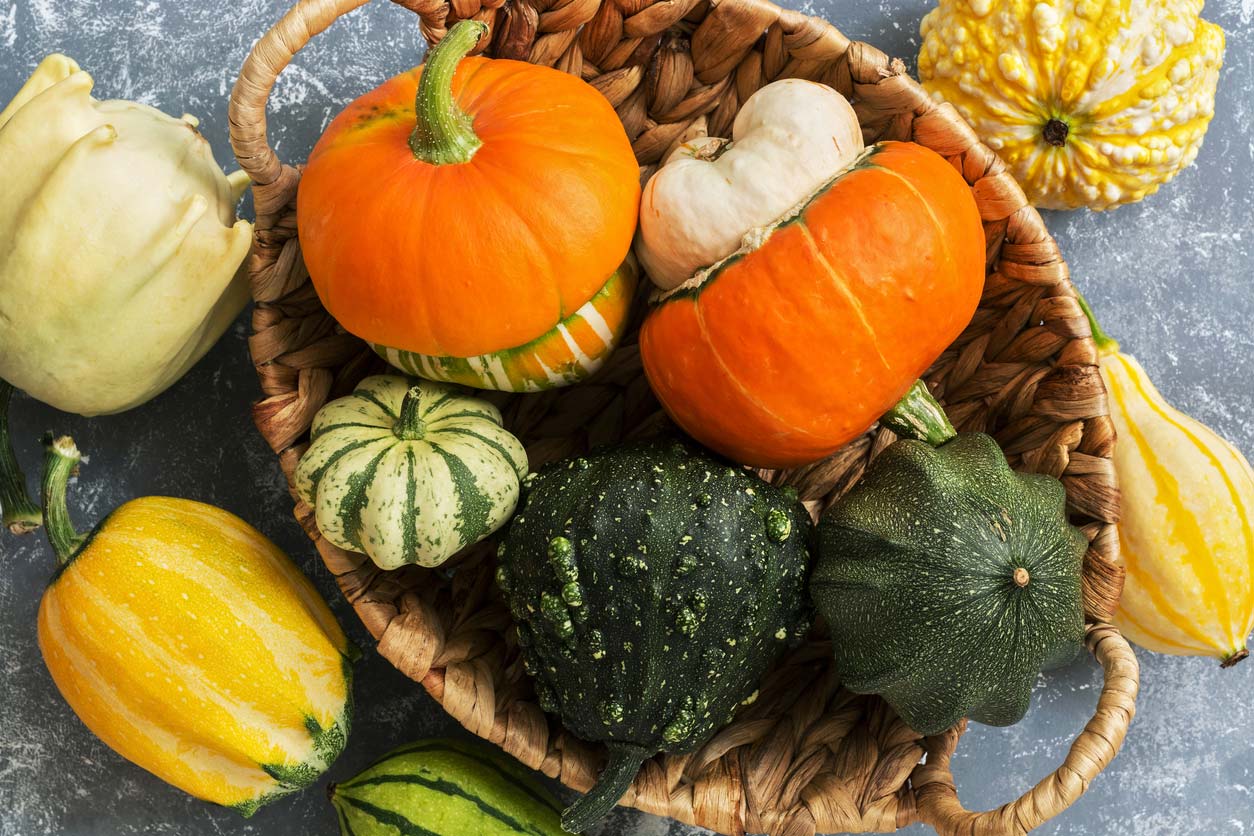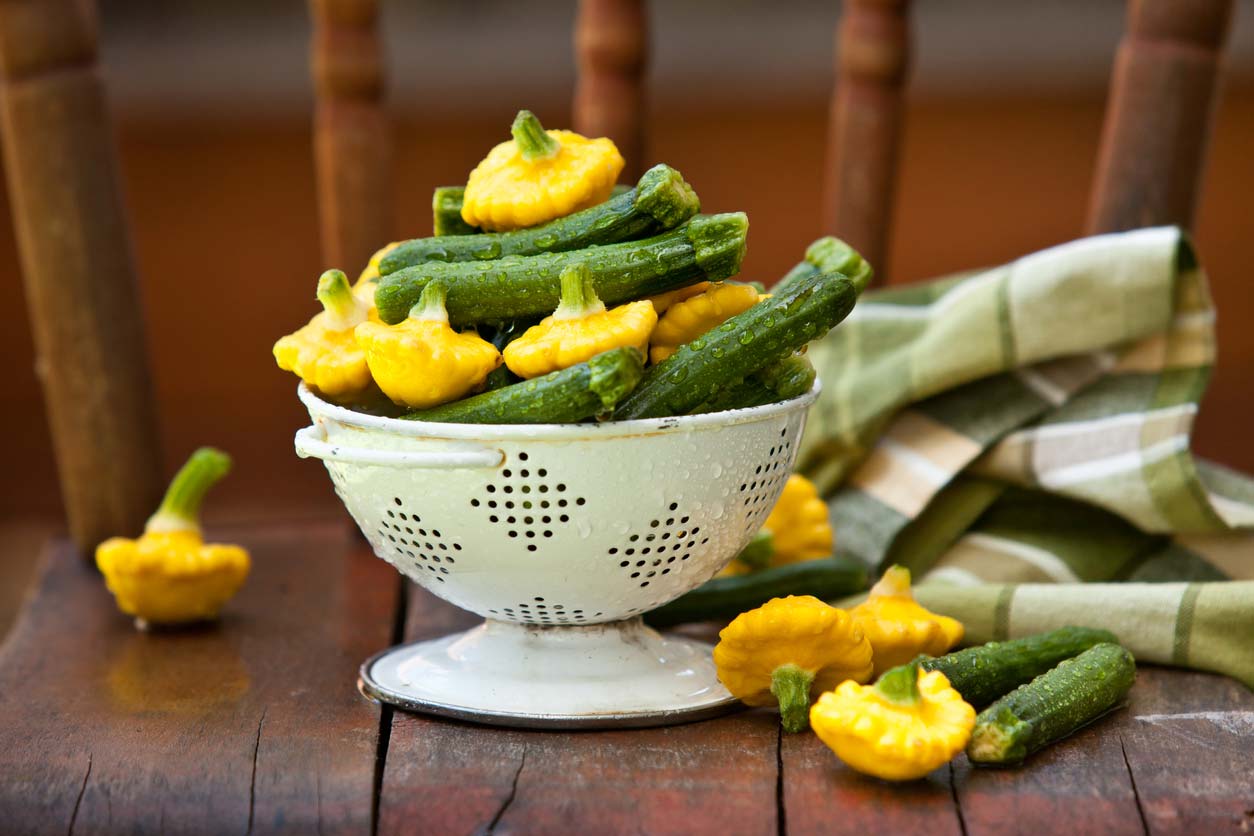The basic kinds of squash are known as summer and winter squash.
Summer squash tend to be smaller (although if you grow zucchini and forget to harvest for a couple of days, be prepared for fruit the size of toddler’s legs!) and are eaten before the rinds and seeds begin to harden. Winter squash take longer to grow, are less symmetrical, and have hardened rinds that are either smooth or rough-textured.Pumpkins are the most famous type of winter squash. Most pumpkins are bred for decorative (hello jack o’lanterns!) rather than edible purposes. But, of course, you can make wonderful pumpkin pies, breads, soups, and other hearty fall delicacies from these big, orange winter vegetables. Surprisingly, most canned “pumpkin” isn’t pumpkin at all, but other varieties of winter squash such as Delicious and Boston Marrow.
Gourds are winter squash grown primarily for decorative and storage purposes, as they have hard shells and unpalatable or even inedible flesh. Gourds make lovely birdhouses, bowls, and percussion instruments.
Here are some of the most popular edible squash varieties:
Winter Squash

Spaghetti squash
These are yellow, oblong squash whose flesh form into spaghetti-like strands when cooked. They’re great as a pasta substitute, baked and topped with tomato sauce and plant-based parmesan, or halved and roasted to give them a nuttier taste.
Butternut squash
These are the longevity all-stars of the squash world. After harvesting, store them in a cool, dark place that has just the right amount of humidity, and they’ll overwinter like champs, lasting 3-6 months or even longer. You can peel, cube, and steam the flesh to make creamy and rich soups and stews. Or slice and roast them with herbs to enjoy butternut squash rings.
Acorn squash
These are, as you might have surmised, shaped like giant green acorns. Small enough to be the centerpiece of a meal for two, acorn squash is awesome baked or roasted. They have a sweet note that can be enhanced by drizzling some cinnamon and maple syrup over the flesh before cooking.
Sugar pumpkins
These are just smallish versions of the classic orange pumpkin. If you’ve ever carved a large orange pumpkin, you know that the flesh can be bland, hard, and fibrous — three adjectives rarely used by admiring chefs. Sugar pumpkins have softer, sweeter flesh that cooks well and offers a lot of flavor and color to holiday dishes.
Carnival squash
Carnival squash is a variety of the adorably-named dumpling squash clan. If you can get a carnival to grow in your garden, prepare for an inundation of fruit. They’re roundish with lovely markings and are great baked, steamed, sliced on the grill, or stuffed.
Banana squash
These are given the heroic name Cucurbita maxima, are related to pumpkins and have absolutely nothing in common with bananas except perhaps a vague resemblance in shape. You can slice them into rings or cubes, and use them as you’d use butternut or any other winter squash.
Summer Squash

Zucchini
Zucchini are long, green summer squash that can range in size from that of a small banana to Popeye’s forearm. They’re all the same plant. The only difference in the size of the fruit is how long they spend on the vine. Given enough sun and rain, and decent soil, a zucchini fruit can grow freakishly large if the gardener isn’t checking daily. Zucchini is really versatile. You can eat them raw (spiralized, they become zoodles, which, thankfully, isn’t also the name of a dog breed), sauteed with basil, stuffed in boat form, breaded and air-fried, grilled in a pan, or pureed in a soup.
Yellow squash
These are zucchini’s yellow cousins. Same shape, similar taste, and similar culinary uses. If you have access to both zucchini and yellow squash, combining them in a dish adds a splash of color that can turn ordinary into festive.
Crookneck squash
These are yellow squash that have thin handles, and look a little like maracas. Prepare them like other summer squash: sauteed, steamed for salads, and in casseroles, as well as in soups and stews, or throw them on a summer grill.
Calabacitas
Spanish for “little squash,” and also known as Mexican squash, Calabacitas come in two shapes: the slender zucchini and the roly-poly round squash. Use it as you would any other summer squash.
Squash Nutrition

While each squash variety boasts a slightly different nutritional profile, they share several strong health benefits. Squash are good sources of vitamin A, C, and B vitamins; they’re high in antioxidants; and they’re rich in minerals such as potassium, magnesium, and manganese. And, of course, as whole plant foods, they’re also rich in fiber and water, making them both hydrating and good for the gut.
Health Benefits of Squash

Squash are high in antioxidants, particularly beta-carotene, vitamin C, and polyphenols. These nutrients help our bodies fight a number of chronic diseases, including type 2 diabetes, cardiovascular disease, and certain cancers. Higher circulating levels of beta-carotene, in particular, have been shown to reduce all-cause mortality.
1. Good for Your Eyes
Eating squash regularly can keep your vision keen too. The beta-carotene and lutein in squash, as well as vitamin C and other antioxidants and anti-inflammatories, are good for the eyes and can help prevent cataracts and macular degeneration.
2. Good for Your Heart
Squash can keep your heart ticking through their abundant supply of carotenoids, which can help lower blood pressure, reduce inflammation, and downregulate the expression of specific genes linked to heart disease. A 2016 analysis of a data set from rural China in the 1980s found that the more fruits and vegetables people ate, the more they were protected from heart disease, as well as gastric cancer and stroke. And yellow and orange squash, in particular, were linked to avoidance of these diseases.
3. Good for Balancing Blood Sugar
Banana squash have traditionally been used as hypoglycemic treatments in northwest Iran as well as China and Mexico. Researchers in Iran tested the power of banana squash to control blood glucose in critically ill diabetic patients. They gave the patients twice-daily doses of powdered banana squash for three days and measured blood glucose and the amount of insulin each patient required. Within 72 hours, the patients’ average blood glucose had dropped from 215 to 178 mg/dl, while insulin requirements decreased around 20%. The study, published in 2018, concluded that the powdered banana squash was a “fast and effective” treatment for critically ill diabetic patients.
4. Good for Your Hair and Skin
Squash should also be on the menu if you want healthy hair and skin. Several compounds found in squash, most notably beta-carotene, are associated with a healthy dermal (skin) microbiome.
5. Cancer-Fighting Compounds
The health benefits of squash varieties like zucchini are myriad: they contain many bioactive compounds that fight cancer. And they do it in multiple ways: from combatting genotoxins (toxic agents that damage DNA molecules and cause mutations and tumors) and cytotoxins (compounds that damage all cells, pretty much indiscriminately), to triggering programmed cell death in damaged cells that might otherwise turn cancerous (a process known as apoptosis).






Комментариев нет:
Отправить комментарий